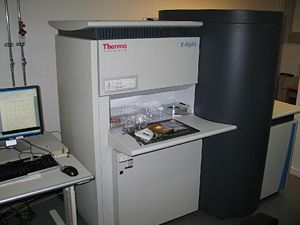Specific Process Knowledge/Characterization/XPS: Difference between revisions
| Line 42: | Line 42: | ||
The technique can be used for different purposes: | The technique can be used for different purposes: | ||
Revision as of 16:01, 27 January 2014
Feedback to this page: click here
XPS-ThermoScientific

A X-ray Photoelectron Spectroscopy (XPS) system can be used at Danchip. The system is a Thermo K-Alpha system, placed in the basement of building 346.
The user manual(s), user APV(s), technical information and contact information can be found in LabManager:
XPS-ThermoScientific in LabManager
Elemental analysis
The XPS instrument can be used to do elemental analysis, chemical state analysis on the sample surface or deeper down by a depth profiling. A comparison about techniques and instruments used for elemental analysis at Danchip can be found on the page Element analysis.
More about the different possibilities with the XPS instrument is found here:
XPS technique
XPS is a surface sensitive and non destructive technique used for analysis of the elemental composition. Only the outermost atomic layers (some nanometers) are probed, but with an ion gun etch it is possible to probe deeper laying layers.
In the XPS spectrometer system the probed samples are irradiated by photons with a specific energy, and the photoelectrons that leaves the sample are detected. The energy levels of the electrons are elemental specific, and by measuring the energy of the outgoing electrons, it is possible to detect which elements that are present in a sample.
You can read further about the technique here: [1]
The technique can be used for different purposes:
Equipment performance of XPS-ThermoScientific
| Purpose | Chemical analysis |
|
|---|---|---|
| Performance | Spot size | Can be set between 30µm - 400µm |
| Probing depth | Depending on probed element. Max probe depth lies within 10-200 Å. | |
| Resolution | Dependent on probed elements. Concentrations down to about 0,5 atomic % can in some cases be detected. | |
| Charge compensation |
Flood gun can be used for charge compensation of non conductive samples | |
| Finding structures | Choose measuring spot from camera image (magnified) | |
| Depth profiling | Purpose | With ion beam etch the top layer of the material can be removed, to do a depth profiling |
| Ion beam size | About 0,3x1 mm | |
| Substrates | Substrate size |
Max 60x60 mm |
| Substrate thickness |
Max height about 20 mm |
